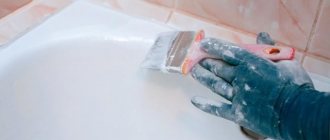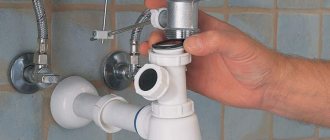A cast iron bathtub is still considered the highest quality product and, unlike other options, is designed to serve its owners for decades. A modern cast-iron bathtub is a mold cast from cast iron, coated with enamel on the inside and weighing 100 kilograms or more.
So, we have a new, or relatively new, cast iron bathtub. God grant that the careful owner follows all the simple rules for caring for its coating and actually enjoys a white, smooth, shiny bathroom for many years.
What if it happened differently? If over time, or at one fine moment, you discover that the bathtub has become dull, rough, and has a coating that cannot be washed off. In this case, the worst suspicions are usually justified: the enamel of the precious bath is damaged. This means not just replacing the bathtub, it means renovating the entire bathroom with a new one, and in the worst case, after broken doors, walls and corners, the entire apartment.
The described trouble also happened to the author of the site, moreover, a year after the global renovation, incl. and a bathroom.
pros
Cast iron has been used to make bathtubs for quite some time. The material is valued for its positive properties. The advantages include:
- Strength, durability, resistance to sudden temperature changes. The cast iron product retains its temperature for a long time, so the water cools slowly, and there is no need to add hot water.
- Maintains shape and does not sag. This is due to the rigidity of the metal and thick walls. Since the bathtubs are quite heavy, they do not need additional supports, since they are securely fastened to the legs. In addition, subsidence and changes in position are eliminated.
- Anti-corrosion coating of the product - so it retains its appearance for a long time. The enamel lays down in an even, smooth layer, shines for a long time and does not scratch.
- Easy to maintain and clean. Since the enamel lays down smoothly and evenly, dirt hardly accumulates on it. The coating is resistant to damage - it can be cleaned with almost all detergents.
- Excellent sound insulation. There is virtually no noise when bathing in the shower or when drawing water.
- Unlimited service life. If you use your bathtub correctly, it will last much longer than other bathtubs.
- The presence of hydromassage, handles and other additions. But they are only available in modern models.
Many people have cast iron bathtubs at home, and most people like them for their high quality. And if damage appears on the product, you can fix it yourself.
What happened?
The acid in detergents eats away enamel. The enamel of an ordinary cast-iron bathtub consists of several layers, the top of which is the so-called glassy coating. It is obtained by firing in a kiln at high temperature and serves not only cosmetic purposes. Another function of the vitreous coating is to protect the base layer of enamel.
The enamel under the glassy coating is very vulnerable. But the glassy coating is not. However, modern means destroy even what is practically glass. As is known, acids have almost no effect on glass. But the thin and sometimes not particularly high-quality enamel coating of modern cast-iron bathtubs helps all sorts of silites and comets in the demise of the entire bathtub and the creation of great moral and material problems for its owner.
The worst thing here is not the loss of the cosmetic appearance of the bath. The main trouble is that the enamel of the bathtub now becomes vulnerable to absolutely everything - water, dirt from you, grains of washing powder, and so on. All this very quickly begins to leave irremovable marks, cracks appear, dirty yellow stains appear, and ultimately it becomes impossible to use the bathroom.
Flaws
However, the following disadvantages should be taken into account:
- Heavy weight. Since the bathtub weighs over 120 kg, physical strength is required to deliver and install it. Hiring movers is required, which leads to additional costs.
- High cost. When a product is of excellent quality from a trusted manufacturer, the price will be noticeably higher than others. You can purchase a cheaper model, but then there is no guarantee of the quality of the product.
- Only standard bathtub shapes are created using cast iron.
There are specific disadvantages to such a product. As can be seen from the above, the advantages far outweigh the disadvantages, so there should be no doubt about the choice when purchasing. We’ll learn how to repair an old cast-iron bathtub in the following sections.
Experiments
The company’s specialists conducted a number of simple but revealing experiments in a factory using cast iron enameled plates similar to the surface of a cast iron bathtub:
Experiment No. 1
- Fine metal chips of various fractions were poured onto the surface of a cast-iron enameled plate and ordinary water was poured on top of the crumbs.
- After some time, the metal chips began to rust, and a rusty spot formed on the enamel surface of the plate under the metal chips.
The results of the experiment can be assessed from the photographs below:
Experiment No. 2
- Water was poured onto the surface of a cast-iron enameled plate. A metal object was placed on top with its flat-polished side.
- After some time, the metal object was removed; on the enamel surface of the plate, along the contour of the metal object, a rusty rim remained (the interaction of the metal with oxygen in the air in the presence of water). However, under the metal object, the enamel surface of the plate remained clean, without traces of rust stains (interaction of metal with water without access to oxygen).
The results of the experiment can be assessed from the photographs below:
The results of the experiments allow us to draw the following conclusion:
On cast-iron enameled plates, similar to the surface of a cast-iron bathtub, the process of oxidation (rusting) of the metal occurs only at the points of contact between the metal and water under the influence of oxygen. This can be clearly seen in the photo, where the formation of a rusty spot under metal shavings is observed, and in the photo, where the rusty outline of a metal object is visible.
Thus, on the enameled surface of the cast iron plate, directly under the metal object, there are no traces of rust due to the absence of oxygen under the metal object at the moment of interaction between water and metal.
PS All rusty stains on cast iron plates can be easily removed with a cleaning agent, the main thing is to do this in a timely manner!
Why does damage occur?
Although the enameled surface is the most durable and reliable, its properties are lost over time due to active use. Even if the operating rules are followed, it is difficult to prevent defects from occurring. You can eliminate the shortcomings yourself.
Before you learn how to repair a cast iron bathtub, you should find out why damage occurs. The reasons for this phenomenon are as follows:
- Since the product comes into contact with water every day, which contains a lot of iron, yellowness occurs. Such interaction has a bad effect on the appearance of the coating.
- Frequent use of chemicals and brushes with hard bristles causes abrasions that look unattractive and create discomfort.
- Dropping small objects into the container can cause damage to the enamel, so the material will gradually peel off from the cast iron.
- Frequent temperature changes and mechanical stress lead to cracks.
Chips on bathtubs are common. They often occur when objects fall into the product. But it is enough to use one of the restoration methods to update the structure.
Where does the damage come from and is it necessary to deal with it: repairing chips in the bathtub
Whatever one may say, more often than not, people ask the question of how to repair a chip on an enameled, cast-iron, or other metal bathtub. All this is because acrylic bathtubs do not have an iron structure inside and even if they are damaged, there is simply nothing for rust and corrosion to corrode. Moreover, it is worth understanding that the price of a metal bathtub will be much less than one made from other materials, and the tendency to damage the enamel is only a small return for excessive savings. True, if you use the bathtub carefully, clean it exclusively with suitable products, and also avoid shocks and other strong mechanical influences, then it can serve faithfully for many years, and without any problems.
Photo from the site: dizain-vannoy.ru
Most often, damage appears immediately, even during the replacement of the bathtub, or renovation of the bathroom itself. After all, it’s so easy to drop pliers on a brand new, snow-white surface, and then, lo and behold, even a hammer. To prevent this, you just need to cover your bathroom with bubble wrap, thick cardboard, foam rubber, old blankets, in general, you can use anything, and you can secure the improvised packaging with regular adhesive tape.
Preparation
How to repair a cast iron bathtub depends on the type of damage. In any case, if cracks, chips, or abrasions appear, repairs are required. But in order to preserve the result of restoration for a long time and withstand mechanical loads and contact with water, preparation of the surface for processing is required. It involves performing the following work:
- It is necessary to clean the product from contamination. It is necessary to remove dust and dirt using a regular alkaline detergent, and then rinse with running water.
- If there is rust in the bathroom, it must be removed. Yellow stains around cracks and chips are eliminated using a rust converter.
- Then the top layer of enamel is removed. Cracks or chips are sanded using fine-grained sandpaper so that the coating is smooth and even. If the damaged area is extensive, use a grinder with a ground disc.
- Degreasing is necessary. Fat is removed from the bath using any solvent - alcohol, acetone, gasoline or acid.
- At the end, the product is dried. To do this, you need to leave it for 24-48 hours. Drying with a construction hairdryer is also used.
Before work, it is necessary to assess the feasibility of such a procedure. In case of single damage, repairs can be done by yourself. In case of extensive damage and through holes, it is advisable to seek help from a specialist.
Alternative: polishing
Bathtub enamel is a fairly durable and difficult-to-scratch coating. However, after much thought and testing, a solution was found. This is an ultra-soft abrasive car polish.
I warn those who are delighted in advance: the work is long, painstaking and can only be done manually. Estimated time - from 5 to 20-30 hours. Naturally, with interruptions, we now have nowhere to rush. ATTENTION! Only enamel that does not have deep scratches, especially cracks and curled dark spots, can be restored. Those. white matte rough enamel after detergents, in particular silite. Under no circumstances should you use a drill with attachments, grinders or other devices, you will damage the enamel even more!
Buy: one bottle of this polish, I recommend: DoctorWax “fine” polishing paste . And the second polish is TurtleWax for glass , also an abrasive polish, but stronger/delicate. The first will go to the initial stage, the second to the finishing stage. Buy white rags in a roll; 1 roll is enough. And be patient.
Use thin polish in sections, rubbing it into the enamel, in a circular motion, onto the damp enamel (without waiting for it to dry, immediately). The longer and more intensively you polish the area, the better. Then the next one. And so on throughout the bath. Then wash it off with a sponge and liquid soap, wipe it off/wait until it dries and do it again. After you use up the bottle, if you worked conscientiously, the bathtub will no longer be matte and rough, but most likely it will still be far from being mirror-like.
Use glass polish after you have used up the first bottle of polish. Here the way of working is different - apply a thin layer of polish throughout the bathroom and wait until it dries. Next, use circular rubbing movements to clean it off in small sections.
The result of the second polish will depend on how much the glassy coating has been eaten away. We roughly rubbed it with the first polish, and polished it with the second until it reflected the surrounding objects. Like a mirror - i.e. It can only reach new condition if it is slightly damaged. In other cases it will be smooth and reflective, but the shine is different, like through frosted glass.
Repairing chips
A small chip with a diameter of up to 2 cm or a crack, as a rule, appears from mechanical stress or pinpoint impacts. They are considered common damage that can be easily repaired. It is advisable to eliminate such defects immediately after detection with special putty and enamel. The procedure for repairing chips is as follows:
- The area around the chip is cleaned of dirt with detergent. It is advisable not to choose abrasive products, as they worsen the destruction of enamel.
- If the metal in the chipped area is corroded, it is wiped with a rust converter.
- The surface is leveled with fine sandpaper.
- The chip is covered with moisture-resistant putty using a spatula.
- After the top layer has dried, sanding is done with the same fine sandpaper.
- The putty is treated with epoxy enamel using a brush, roller or aerosol in several layers.
This is a simple way to repair a cast iron bathtub with your own hands. It should be taken into account that local repair of chips in enamel provides a temporary effect, delaying the time of global treatment. Aerosol enamels do not hold up well, but they are easier to use.
Causes of damaged bathtub coating
If the cast iron bathtub is less than 5 years old and there is no manufacturing defect, then there can only be one reason for the damaged enamel: modern detergents.
The fact is that most modern detergents contain acid (usually oxalic), which has an aggressive effect on the enamel of the bathtub. This is indicated on the label, but usually at the bottom and in small letters. The meanness of the action of such products lies in the fact that if the enamel of the bathtub is strong, then it is not corroded the first time, but gradually. Sometimes, for several years.
Your humble servant knows all this very well, but he didn’t have time to keep track of the others. When I noticed what happened, it was already too late. A new, completely matte and rough bathtub appeared.
Painting
So, how to repair a cast iron bathtub? For this, the painting method is used. If there are a lot of chips and cracks on the surface, and there is also rusty, limescale deposits, repairs with a “patch” will not work. To restore the appearance of a heavily damaged product, paint is used. Before applying dyes, the bowl is cleaned of dirt, the enamel coating is removed, degreased, and then dried. The following means are used for processing:
- Liquid acrylic. The product includes 2 components - liquid acrylic and hardener. It is applied to the inside of the bowl using a pourer or a roller. Coating a cast iron bathtub with acrylic is a simple process. The coloring composition dries within 3-5 days, during which it is forbidden to wet the surface with water or touch it. The layer will be even, smooth, glossy. This coating lasts at least 8-15 years without turning yellow, since the thickness is at least 6 mm. The acrylic coating of the cast iron bathtub is of high quality and has a neat appearance.
- Epoxy enamel. It contains a base, a hardener and a plasticizer. The mixture is thick, viscous, and sets quickly, so it must be processed quickly and carefully. The enamel should be applied with a soft roller, natural brush or aerosol. Polymerization is carried out within 7 days. The bath should not be used during this time. The coating will be thin, hard, and fragile, so it will last no more than 5 years.
To repair a cast-iron bathtub, it is advisable to choose liquid acrylic, since it is much easier and smoother to apply compared to epoxy enamel. The disadvantage of this method is the high price and long drying time. Repairing a cast iron bathtub with acrylic is one of the most popular methods.
Toothpaste with whitening effect
Acrylic is actively used in dentistry. It is used to veneer denture frames. Therefore, it is quite acceptable to clean the bathtub from yellow plaque using toothpaste with whitening properties without abrasive particles.
The paste can also be replaced with tooth powder, first diluting it with water to a paste-like consistency.
Algorithm of actions:
- Apply the paste to a soft sponge or cloth.
- Wipe the surface, paying special attention to areas with large accumulations of plaque.
- Leave for 40-60 minutes.
- Rinse off with warm clean water.
- Wipe dry with a soft cloth.
Using acrylic
Acrylic processing is performed as follows:
- We need to prepare the bath.
- Then the acrylic is diluted using a hardener, as described in the instructions on the package.
- You should remove the siphon from the bath and place a container there - excess acrylic is poured into it, which will then be used.
- The top edge of the product should be watered with acrylic. After the jet reaches the middle of the wall, you need to move the jar with acrylic around the perimeter until the entire circle has been passed.
The bathtub must be watered around the perimeter. It is important that the stream hits the middle of the walls. You need to work continuously, otherwise the acrylic may set in some places and there will be streaks. Drying takes 1-4 days. Typically, instructions for applying paints are indicated on the packaging. Although such a procedure is always carried out according to the same scheme, each manufacturer may have some nuances that should be taken into account when working.
A through crack or hole in an acrylic bathtub
For through cracks or holes in acrylic products, more fundamental repairs are required. Typically, such destruction also occurs due to rough physical impact on the product. In this situation, our master also bores out the crack along the edges at the beginning, so that it does not spread further along the body. Then, on the back side of the bath, around the crack or hole at a distance of 5-10 cm in a circle, the base of the product is cleaned using an abrasive. Next, quick-drying epoxy glue is applied to the back of the cleaned side of the bathtub, and a reinforcing mesh and fiberglass impregnated with epoxy resin are laid on top of it. After our patch has dried, the acrylic that is lagging from the base is removed from the front of the bathtub and then this place is cleaned with abrasive and degreased. Next are 2 repair options:
- Pre-tinted acrylic putty or acrylic is applied to the cleaned area. Afterwards, this place is subjected to grinding of various grain sizes with abrasive and only after this the prepared place is polished.
- Putty is applied to the cleaned area. After it has completely dried, the entire bath or tray is cleaned with abrasive and the surface is removed from dust and degreased. Then the siphon is dismantled, and the drain hole is also cleaned. Then, self-leveling acrylic is applied to the entire area of the bathtub. After 24 hours, you can install the siphon.
Fixing a through hole in an acrylic bathtub
For through holes in acrylic bathtubs, in addition to acrylic putty, reinforcement with steel plates and fiberglass impregnated with quick-drying epoxy resin are also used. After reinforcement, acrylic putty is applied to the damaged area and after it has completely dried, it is ground flush with the surface and polished using polishing pastes of various grain sizes. The result is a uniform, glossy surface. But for a better result, instead of local restoration, it is better to do a full acrylic fill on the bathtub. To do this, after reinforcing the hole with metal plates and fiberglass, as well as leveling the surface with putty and sandpaper, the entire preparatory stage for applying bulk acrylic is applied and the surface is completely filled with acrylic.
Liner
If the product has a lot of cracks, chips and deformations, then the cast iron bathtub should be repaired using a special acrylic insert. Its shape follows the geometry of the old bowl; it is inserted inside it, and then secured with adhesive foam and sealant.
The disadvantage of a bath liner is:
- High price. A quality product is expensive, the cost is more than half the price of a cast iron bathtub.
- Small assortment. Choosing a liner for a bathtub is sometimes difficult, especially if it is non-standard.
- Cannot be used to repair thin-walled bowls. If the product is made of thin cast iron, then repair with an acrylic insert is impossible, since the walls are deformed under mechanical loads.
The main advantage of restoration with an acrylic liner is the effectiveness of the method, since it restores bowls even with through holes. Such an insert serves for at least 15 years.
Salt
Of all types of acrylic surface stains, rust stains are the most difficult to deal with. However, table salt can do this task too. To make a cleaning product, you will need fine table salt, diluted to a paste with the juice of half a lemon (can be replaced with two tablespoons of vinegar). The mixture is applied to the rusty stains and left for at least a quarter of an hour, and then washed off with water. It should be borne in mind that you cannot rub the composition into the surface, otherwise scratches will appear.
The choice of cleaning method for a bathtub with an acrylic coating, which is prone to scratches and other mechanical damage, must be approached wisely. Folk remedies are one of the safest ways to remove dirt from a bathtub. But in order not to spoil the surface, you should properly prepare and apply homemade compositions, first testing them on an inconspicuous area.
Price
The price of repair depends on the chosen method. How much does enameling cost? The cost of Reaflex 50 enamel from Tikkurila is 550 rubles per 1 kg. The price of the Russian restoration kit “Svetlana” is 750 rubles. As a result, you will have to pay 1300 rubles. If you choose a kit for restoration with liquid acrylic, for example Plastall, it will cost 2,000 rubles. It includes everything you need for independent work, even a CD with a video lesson.
The price of an acrylic liner is 2800-3000 rubles. The best method would be the self-leveling restoration method, which produces a beautiful, durable coating for little money. In addition, all of the above methods are much cheaper than purchasing and installing a new product.
Full or partial restoration of enamel
This issue is considered in each case individually, since it is necessary to take into account the condition of the enamel, service life and the amount of damage. If small chips were received during the delivery or installation of a new bathtub, then local treatment can be performed. But even in this case, problems may arise with selecting the color tone and creating a certain coating thickness. That is, traces of restoration will be, albeit slightly, noticeable. After removing the rust stains, the contrast will be more pronounced because the enamel has acquired a yellowish tint. Therefore, if quick measures are taken to preserve the metal, partial processing and finishing can be done, but to obtain the quality of the coating, complete restoration is done.
Care
In order for the bathtub to remain like new for a long time, it is necessary to properly care for it. To do this, use these tips:
- After use, the product should be washed with a sponge and non-abrasive detergent.
- Many people think that you need to rinse with running water. This needs to be done, but you also need to wipe it dry.
Fresh stains can be easily removed with regular soap foam. Old stains can be removed using baking soda, vinegar, bleach or laundry soap. The listed products are ideal for a modern bath that has durable and non-porous enamel.
Do not use abrasives or compounds containing concentrated acids. Do not use metal brushes or blades. Heavy dirt, limescale, and rust can be removed with special products that are sold in hardware stores.
Bath cleaning products
The simplest and most common way is to use special bathroom cleaning products. The main thing for making the right choice is to carefully read the product presented on the packaging so that it does not contain prohibited substances. Safe home remedies also work well.
- Detergent.
- Lemon acid.
- Vinegar.
- Soda.
- Toothpaste.
Citric acid solution
This type of cleaning is very popular and economical. Since this material perfectly cleans plaque, fats and other contaminants. The main thing to remember is that citric acid in its pure form is not suitable for acrylic, so for its practical use you need to prepare a solution. Fill the bathtub with warm water, then pour in half a liter of acid, stir and leave overnight.
Apple vinegar
Cleaning these materials is very effective, but it does not always give a positive effect specifically for the material itself. You should work with vinegar quickly and carefully.
Soda
It is the best assistant in cleaning not only the bathroom, but the entire house. When working with acrylic, you should only use baking soda, as it is less alkaline. The main thing is to use only diluted soda so as not to damage the bathtub body.
Toothpaste
Since acrylic material came to wide consumers through dentistry, it is quite natural that this material can also be cleaned with toothpaste
It is important to use only non-abrasive toothpaste for use.
Using any of these methods, you can clean acrylic from any strong or light stains, and your clean and sparkling bath will delight you for a very long time.
Nuances
If you are enameling a bathtub, it is advisable to apply 2 layers with a brush or roller, and the final layer with a spray gun. Then the coating will be smooth, and the quality will remain for 5 years. When using toxic or flammable substances, rubber gloves and a respiratory bandage must be used. Even if your bathroom is renovated, you should take proper care of it. Then the product can last for many years. Therefore, the next repair will be carried out not because the plumbing is unsuitable, but because of the desire to update the situation.
Enamel for bathtub restoration – which one to use?
It is best to use nitroenamel NTs-11 in jars. There are similar ones, but in cans. They are not recommended because they contain a solvent, which causes the enamel to not last as long as it should.
If NTs-11 is not found, synthetic melamine alkyd enamel will do. Only it must be dried with a reflector for 30 minutes at a temperature of 100-130 degrees, because it will never dry at room temperature.
Pay special attention to the temperature: if it is less than 100, the enamel will not dry, if it is more than 130, it will be destroyed.
That's all. Thank you for your attention.











